Abstract
Objectives
The purpose of this study was to evaluate the therapeutic effect of three different types of sounds on tinnitus patients undergoing tinnitus retraining therapy (TRT).Methods
This is a single-institution retrospective study, performed in one tertiary otological referral center. Thirty-eight adults with subjective idiopathic tinnitus who were followed for at least 9 weeks were enrolled. Sound therapy was delivered in 3 different ways: narrowband noise TRT (nTRT); mixed band noise TRT (mTRT); broadband noise TRT (bTRT). Treatment response was measured through validated psychometric questionnaires: Tinnitus Handicap Inventory (THI), visual analog scale (VAS) on annoyance, and numerical description of hours of tinnitus perception (awareness hours).Results
A total of 38 patients were followed for at least 9 weeks. In nTRT group, all outcome measures including THI, VAS, and the awareness hours, decreased over 9 weeks with no statistical significance. In mTRT group, all outcome measures except for awareness hours significantly improved 9 weeks after the beginning of the treatment. In bTRT group, all outcome measures decreased significantly in 9 weeks. When therapeutic success is defined as improvement in THI 7 or more, bTRT group (77.8%) showed a higher success rate than other groups for 38 patients with the minimum follow-up of 9 weeks.Conclusion
All three sounds can provide relief in patients with annoying tinnitus after TRT. However, there is difference in the therapeutic effect according to sound types. Broadband sound seems to be better than narrowband sound or mixed sound in relieving the patients from tinnitus. Therefore, sound therapy with broadband noise may be more appropriate during TRT, but further evidence is needed for precise conclusion.Free full text

Effect of Different Sounds on the Treatment Outcome of Tinnitus Retraining Therapy
Abstract
Objectives
The purpose of this study was to evaluate the therapeutic effect of three different types of sounds on tinnitus patients undergoing tinnitus retraining therapy (TRT).
Methods
This is a single-institution retrospective study, performed in one tertiary otological referral center. Thirty-eight adults with subjective idiopathic tinnitus who were followed for at least 9 weeks were enrolled. Sound therapy was delivered in 3 different ways: narrowband noise TRT (nTRT); mixed band noise TRT (mTRT); broadband noise TRT (bTRT). Treatment response was measured through validated psychometric questionnaires: Tinnitus Handicap Inventory (THI), visual analog scale (VAS) on annoyance, and numerical description of hours of tinnitus perception (awareness hours).
Results
A total of 38 patients were followed for at least 9 weeks. In nTRT group, all outcome measures including THI, VAS, and the awareness hours, decreased over 9 weeks with no statistical significance. In mTRT group, all outcome measures except for awareness hours significantly improved 9 weeks after the beginning of the treatment. In bTRT group, all outcome measures decreased significantly in 9 weeks. When therapeutic success is defined as improvement in THI 7 or more, bTRT group (77.8%) showed a higher success rate than other groups for 38 patients with the minimum follow-up of 9 weeks.
Conclusion
All three sounds can provide relief in patients with annoying tinnitus after TRT. However, there is difference in the therapeutic effect according to sound types. Broadband sound seems to be better than narrowband sound or mixed sound in relieving the patients from tinnitus. Therefore, sound therapy with broadband noise may be more appropriate during TRT, but further evidence is needed for precise conclusion.
INTRODUCTION
Tinnitus is generally defined as a perception of sound in the absence of an external acoustic stimulus. Tinnitus affects approximately 50 million Americans and more than 600 million individuals worldwide [1,2]. Tinnitus can be classified into two main types: subjective and objective tinnitus. Objective tinnitus is caused by sounds generated in the body and conducted to the ear, such as vibrations of turbulent blood flow [3], myoclonus, or muscle contractions. Individuals with subjective tinnitus have no visible signs of disease, and the disease has few detectable physical correlates. Subjective tinnitus which comprises most of tinnitus [4] is of our concern and will be referred to as 'tinnitus' for the remainder of this paper.
Tinnitus negatively affects overall quality of life including daily activity and social activity. The etiology is not fully understood and thus no treatment method can completely cure tinnitus. There is no single treatment for tinnitus: many modalities including life style modifications, medications, masking, transcranial magnetic stimulation and retraining have turned out to be imperfect [5]. Among the various treatments tinnitus retraining therapy (TRT) is one of the methods that is widely used in tinnitus clinics. TRT is a well-established treatment modality of tinnitus and a published article demonstrated an 80% improvement in tinnitus patients treated with TRT [6]. TRT involves directive counseling, which is based on the neurophysiological model of tinnitus, and sound therapy [7]. According to a randomized controlled trial on the effect of TRT and tinnitus masking, the long term effect of TRT was excellent while its short term effect was inferior to tinnitus masking [8]. There is no doubt that ultimately long term effect is important in the treatment of tinnitus; however, a short term effect is also important to increase the patient compliance. In order to overcome the inadequacy of TRT short term effect, we have recently introduced the concept of mixed TRT [9]. In mixed TRT directive counseling is same as traditional TRT; however, sound therapy of the mixed noise TRT (mTRT) is performed with a mixture of broadband noise and narrowband noise. The broadband noise was adopted to improve the long term effect and the narrowband noise was adopted to improve short term effects. According to Jastreboff's original description of TRT, broadband noise was used for sound therapy to decrease the strength of the tinnitus signal by increasing the level of background neuronal activity in the auditory system [10]. But the therapeutic effect of each sound type is not fully understood. Also it is not known if broadband noise is the optimal sound for TRT sound therapy. The purpose of the present study is to evaluate and compare the therapeutic effect of three types of sounds in tinnitus treatment.
MATERIALS AND METHODS
In this study, we included 38 patients with subjective idiopathic tinnitus: 24 men and 14 women, who were followed for at least 9 weeks between March 2008 and December 2010. Patients were classified into 3 groups on the basis of the type of sound introduced: narrow band noise TRT (nTRT), mTRT, broadband noise TRT (bTRT). All patients underwent a standardized intake assessment [11] including full history taking, physical examination by an otolaryngologist and questionnaires including the Korean version of Tinnitus Handicap Inventory (THI), visual analog scale (VAS) on annoyance and numerical description of hours of tinnitus perception. The questionnaires have been validated for psychometric adequacy [12]. Audiologists performed a full audiologic assessment including loudness and pitch matching, minimum masking levels, and residual inhibition.
Patients were allocated to each sound type according to their visiting period, firstly nTRT was adopted, later mTRT, lastly bTRT was used for the treatment of tinnitus. This is not a prospective randomized clinical trial, however, the staged implementation of three different sounds supported such a comparative evaluation. Although the three programs were separated in time, they were the same in terms of intended protocols, physician in charge, counseling methods, sound therapy device, and location of the program. The only intended difference was the type of sound used for TRT sound therapy. Patients were assigned to nTRT, mTRT or bTRT: 8 in nTRT (5 males, 3 females; mean age, 38.9±9.8 years); 12 in mTRT (8 males, 4 females; mean age, 47.78±13.5 years); 18 in bTRT (11 males, 7 females; mean age, 55.7±15.4 years), respectively.
Patients' data were collected at 2 points: 1-5 week and 9-13 week. No differences were found in the mean number of weeks at each follow-up point among three groups. For 1-5 week, mean follow-up period was 2.86±1.22 weeks for nTRT group, 2.82±1.08 weeks for mTRT group, and 2.43±1.28 weeks for bTRT group (P=0.967). For 9-13 week, mean follow-up period was 10.5±2.38 weeks for nTRT group, 10.75±1.96 weeks for mTRT group, and 11.00±1.68 weeks for bTRT group (P=0.393).
Sound therapy
Sound therapy was conducted with a MP3 player (Sandisk, Milpitas, CA, USA; CE007K, LETO GMS, Seoul, Korea). In the nTRT group, narrowband noise that matched to the patient's tinnitus pitch was provided to the patient. In mTRT group, initially narrowband noise was used to mask the tinnitus for short term (≤1 months), then for the next 2 months of treatment, the composition of sound was changed from the dominance of narrowband noise to the dominance of broadband noise (white noise). In bTRT group, white noise was used from the beginning. The patients were instructed to set the volume of noise generator at the mixing point [13].
Counseling
During sound therapy, patients attended counseling appointments with the otolaryngologists at 1, 2, and 3 months and completed questionnaires. At the first visit, patients received a 15 minute counseling about causes of tinnitus, why tinnitus becomes a problem, explanation of habituation as a goal and were reassured. Every month after the first visit, patients attended ongoing counseling for 5 minutes with the otolaryngologists to check subjective annoyance, compliance to treatment and repeated explanation of habituation as a goal.
Outcome measures
Three outcome instruments (Korean version THI, VAS on annoyance, numerical description of tinnitus perception) were used. The THI has 25 items and a range of 0-100 (α=0.93; r=0.92) [12]. VAS of annoyance was measured from 1 to 10 scale with 10 most severe. Numerical description of hours of tinnitus perception (awareness hours) was measured from 0 to 24 scale with 24 most severe. Therapeutic success was defined as a minimum THI change of 7 points, according to a former publication [14]. The successful treatment rate was defined as the proportion of patients who improved 7 points or more in THI, and the success rates were compared between groups. To assess the efficacy of the treatment within each group and to compare the efficacy between the three different groups, the results of 38 patients were analyzed.
Statistical analysis
The Wilcoxon signed rank test was calculated for a comparison of THI, VAS, and awareness hours over time within each group. The Kruskal-Wallis test and linear by linear association analysis were used to compare the THI, VAS, awareness hours, and success rate between groups. Null hypotheses of no difference were rejected if P-values were less than 0.05. The data analyses were performed using IBM SPSS ver. 19.0 (IBM Co., Armonk, New York, USA).
RESULTS
Treatment outcome within each group
In the nTRT group, all outcome measures including THI, VAS and the awareness hours decreased after 9-13 weeks (Fig. 1). THI decreased from 48.25±25.56 to 42.00±29.55 (P=0.398), VAS decreased from 6.50±1.60 to 5.63±1.69 (P=0.102), and the awareness hours decreased from 16.75±8.41 to 15.13±10.82 (P=0.581), respectively. But the differences did not reach statistical significance.
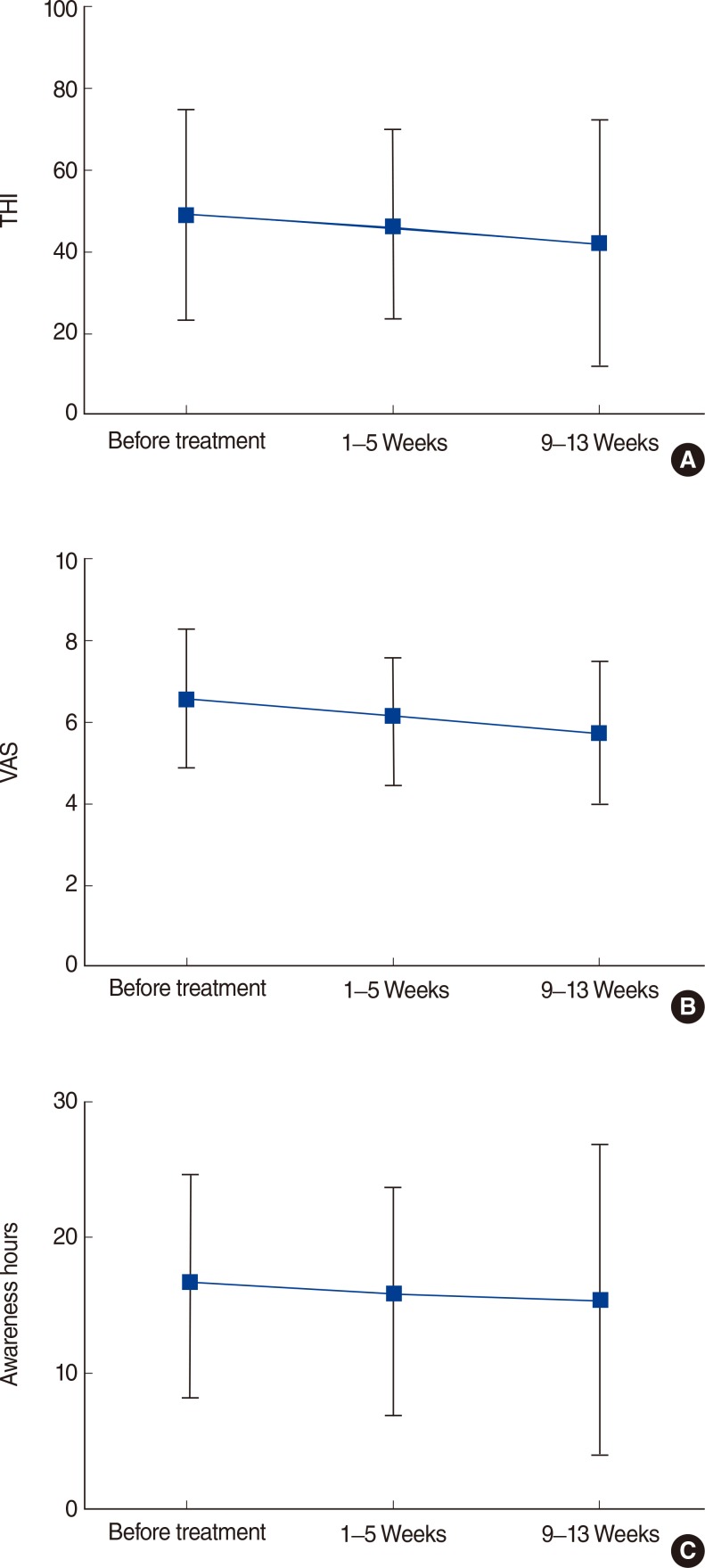
Mean changes from baseline in questionnaire scores for patients who were treated with narrowband noise tinnitus retraining therapy (nTRT) and followed for more than 9 weeks. All three outcome measures including Tinnitus Handicap Inventory (THI) (A), visual analog scale (VAS) (B), and the awareness hours (C) decreased after 9-13 weeks. THI decreased from 48.25±25.56 to 42.0±29.55, VAS decreased from 6.50±1.60 to 5.63±1.69, and the awareness hours decreased from 16.75±8.41 to 15.13±10.82, respectively.
In mTRT group, THI and VAS significantly decreased for the duration of 9-13 weeks (Fig. 2). THI decreased from 42.5±22.27 to 29.0±26.55 (P=0.041), VAS decreased from 6.17±1.34 to 4.33±2.06 (P=0.022), respectively. Awareness hours decreased from 16.67±9.25 to 9.83±10.94 but it did not reach statistical significance (P=0.08).
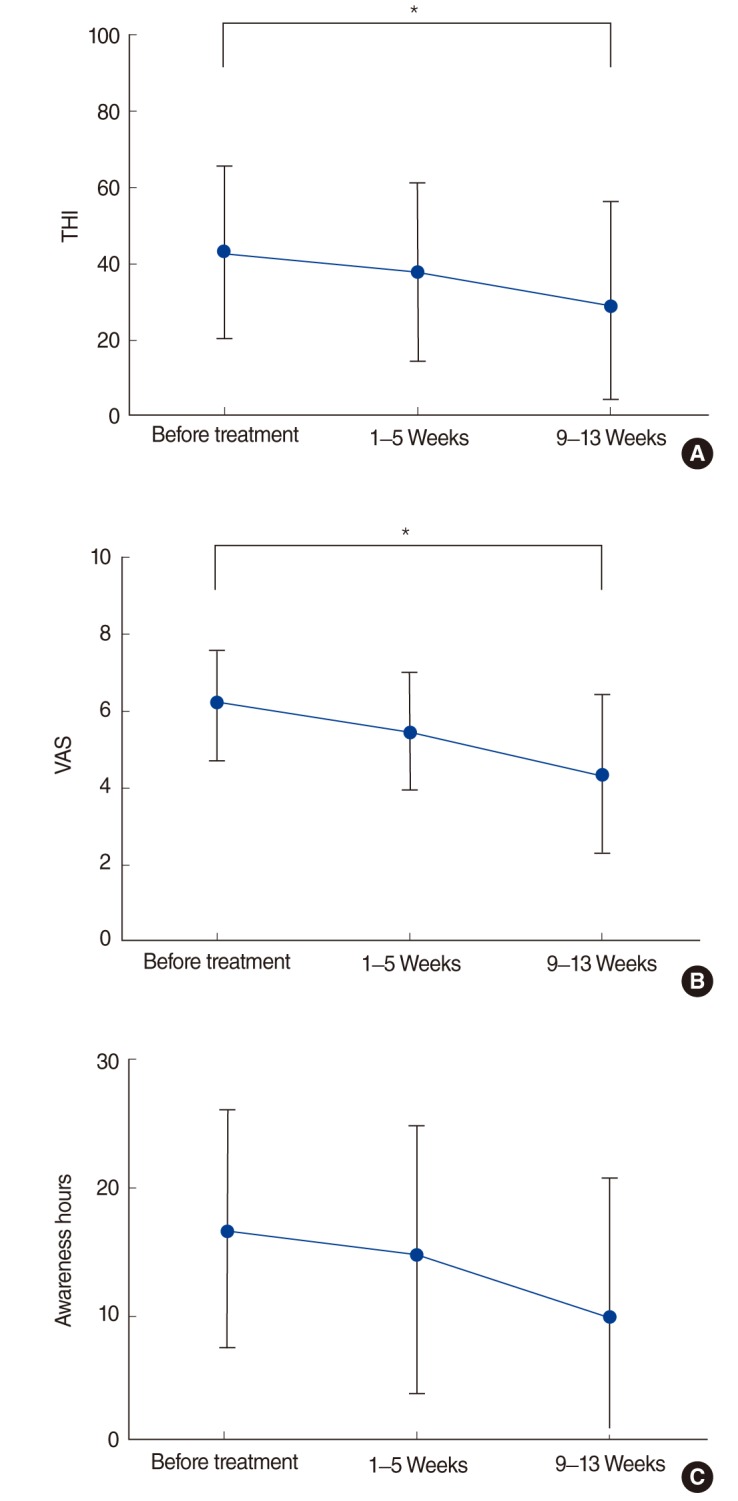
Mean changes from baseline in questionnaire scores for patients who were treated with mixed noise tinnitus retraining therapy (mTRT) and followed for more than 9 weeks. In mTRT group, Tinnitus Handicap Inventory (THI) (A) and visual analog scale (VAS) (B) significantly decreased for the duration of 9-13 weeks. THI decreased from 42.5±22.27 to 29.0±26.55, VAS decreased from 6.17±1.34 to 4.33±2.06, respectively. Awareness hours (C) decreased from 16.67±9.25 to 9.83±10.94 but it did not reach statistical significance. *P<0.05.
In bTRT group, all outcome measures improved significantly for 9-13 weeks (Fig. 3). THI decreased significantly from 54.22±22.41 to 35.11±22.44 (P=0.001), VAS from 6.50±1.47 to 5.11±2.14 (P=0.017), and the awareness hours from 18.17±8.63 to 13.83±10.00 (P=0.008).
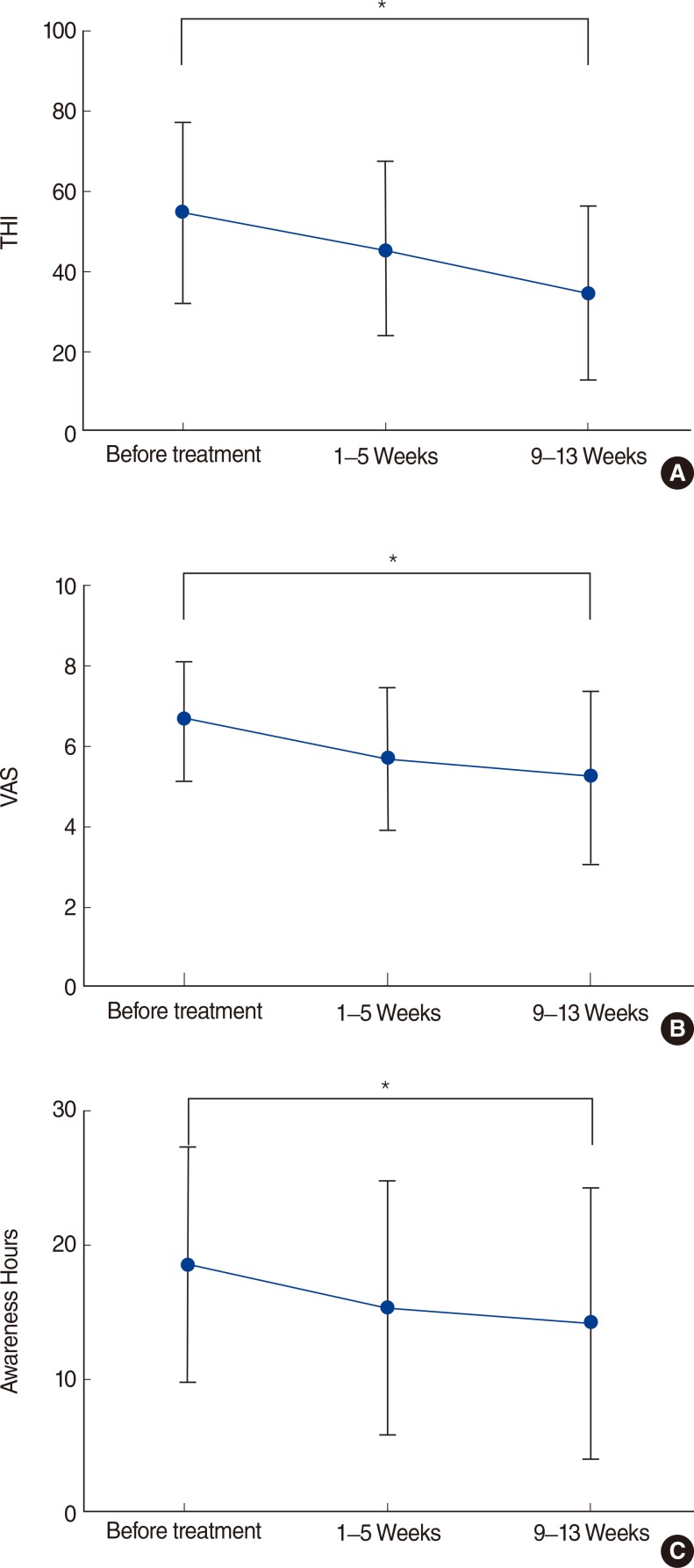
Mean changes from baseline in questionnaire scores for patients who were treated with broadband noise tinnitus retraining therapy (bTRT) and followed for more than 9 weeks. In bTRT group, all outcome measures showed a statistically significant improvement for 9-13 weeks. Tinnitus Handicap Inventory (THI) (A), visual analog scale (VAS) (B), and the awareness hours (C) decreased significantly from 54.22±22.41 to 35.11±22.44, from 6.50±1.47 to 5.11±2.14, and from 18.17±8.63 to 13.83±10.00, respectively. *P<0.05.
Treatment outcome difference between groups
A gradual improvement over time in THI score was found in all groups (Fig. 4A). When the change in THI score was compared between groups, bTRT group seemed to show the best results, nTRT showed the poor results, and the effect of mTRT was intermediate. But, it did not reach statistical significance. VAS also showed a general improvement over time in all three groups. When compared between groups, VAS outcome was comparable between mTRT group and bTRT group, but it was relatively poor in the nTRT group (Fig. 4B). In terms of awareness hours, a general improvement was shown for the duration of 9-13 weeks. When the change in awareness hours was compared between groups, mTRT group and bTRT group showed the comparable improvement, and nTRT group showed the poor result without statistical significance (Fig. 4C).
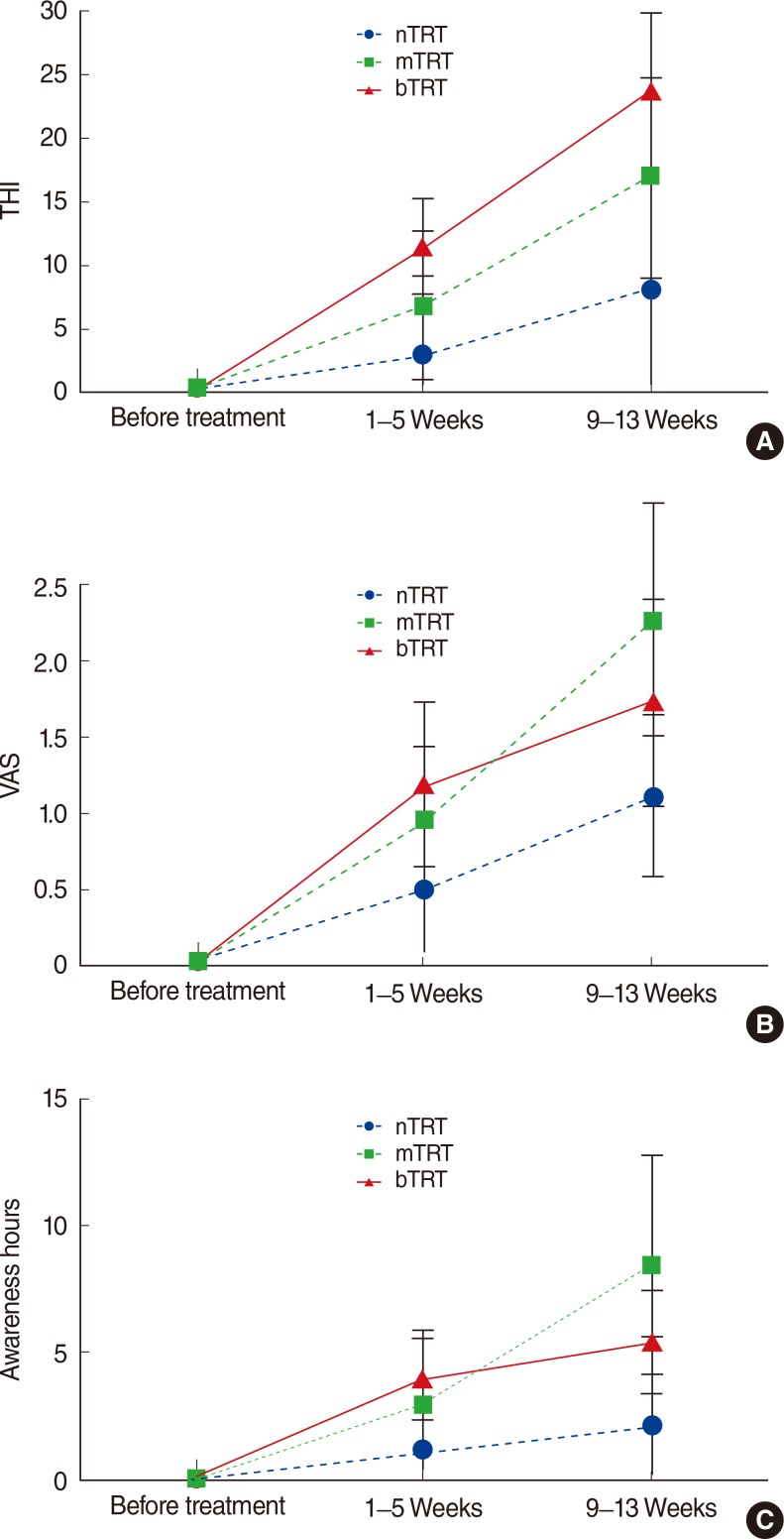
Improvement in Tinnitus Handicap Inventory (THI), visual analog scale (VAS), and awareness hours for patients who were followed for more than 9 weeks. A gradual improvement over time in THI score was found in all groups. When the change in THI score was compared between groups, broadband noise tinnitus retraining therapy (bTRT) group seemed to show the best results, bTRT showed the poor results, and the effect of mixed noise tinnitus retraining therapy (mTRT) was intermediate (A). VAS also showed a general improvement over time in all three groups. When compared between groups, VAS outcome was comparable between mTRT group and bTRT group, but it was relatively poor in the narrowband noise tinnitus retraining therapy (nTRT) group (B). In terms of awareness hours, a general improvement was shown for the duration of 9-13 weeks. When the change in Awareness Hours was compared between groups, mTRT group and bTRT group showed the comparable improvement, and nTRT group showed the poor result (C). However, all this result did not reach statistical significance.
The successful treatment rate was 77.8% for bTRT, 58.3% for mTRT, and 37.5% for the nTRT group. Success rate was compared between groups with linear by linear association analysis and sound therapy with broadband noise showed better results than that with narrowband noise and mixed noise (P=0.037) (Fig. 5).
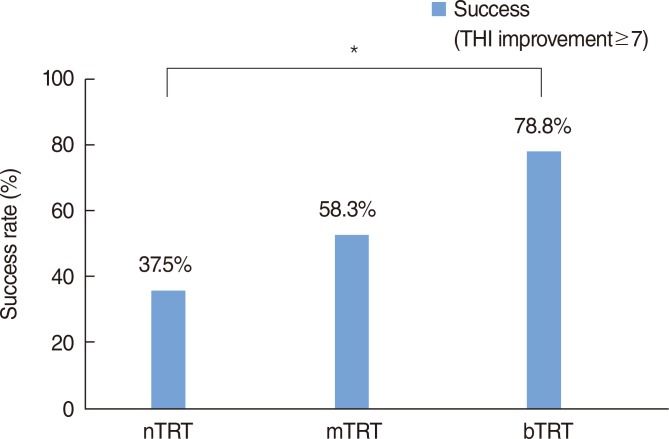
Comparison of successful treatment rate between groups. The successful treatment rate was 77.8%, 58.3%, and 37.5% for broadband noise tinnitus retraining therapy (bTRT), mixed noise tinnitus retraining therapy (mTRT), and narrowband noise tinnitus retraining therapy (nTRT) group respectively. Sound therapy with broadband noise tended to show better results than that with narrow band noise and mixed noise. THI, Tinnitus Handicap Inventory. *P<0.05.
DISCUSSION
It is generally accepted that sound therapy with broadband noise is suitable for TRT. But this practice is based on theoretical assumptions that broadband noise may activate the greatest number of auditory nerve fibers facilitating habituation [10]. To the best of our knowledge, there has been no study in the literature that has directly compared the difference in treatment outcome of different types of sound therapy. From this study we were able to find that all three sounds can provide relief in patients with annoying tinnitus after TRT. But there seems to be a difference in the amount of therapeutic effect: TRT sound therapy with broadband noise seems to be more helpful to tinnitus patients than that with narrowband noise. We found a clear dose response relationship between the proportion of broadband noise and the amount of therapeutic effect. That is, the successful treatment rate increased linearly as the proportion of broadband noise in sound therapy increased. Also, improvement in THI score was greatest in the bTRT group, intermediate in the mTRT group, and smallest in the nTRT group.
TRT is based on the neurophysiological model of tinnitus introduced by Jastreboff [15]. Sound therapy implemented in TRT is aimed to desensitize/weaken tinnitus-related neuronal activity [16] and has a broad range of options including environmental enrichment devices, hearing aids, sound generators and portable music players [17,18]. More recently, music with an embedded broadband noise was used in the development of an acoustic desensitization protocol [18]. Although many kinds of sound are available, in general broadband noise is thought to be appropriate for habituation of the tinnitus perception. This study leaves much to be desired, but we tried to verify this hypothesis by comparing the treatment outcome of different sound therapies. From our results, it seems that Jastreboff's theoretical speculation was correct and TRT sound therapy should be performed with a broadband noise in order to achieve maximal desensitization effect.
According to the randomized controlled trial reported by Henry et al. [8], the short term effect of TRT is poorer than tinnitus masking. The time point when the treatment outcome of TRT overtakes that of tinnitus masking is approximately 6 month after treatment initiation. This may mean that patients undergoing TRT may be unsatisfied with the treatment outcome for several months and may give up the treatment program. In order to overcome this problem, we have introduced nTRT and mTRT which is quite similar to tinnitus masking for the first 1 month in terms of sound therapy. Before analyzing our results, we expected to find a better short term outcome in the nTRT and mTRT group. But against our expectation, bTRT group showed comparable outcome from the beginning (1-5 weeks). The reason for this discordance between our results and that of Henry et al. is not clear. But it may be that the masking effect was insufficient for the patients who have undergone nTRT or mTRT. As for tinnitus masking, the patients are usually instructed to adjust the volume of noise according to their preference: patients may increase the volume of noise until their own tinnitus is completely masked out [10]. But in our study all elements of counseling and instructions on noise generator use were based on TRT. That is, the patients were instructed to set the volume of the noise generator at the mixing point. This volume level may be insufficient to relieve the patient of their distracting tinnitus. If we have instructed the nTRT and mTRT group to adjust the volume of noise as they wished, the treatment outcome may have been different. Although this point is an important issue, we prefer not to instruct the patients to adjust the volume at full level. During TRT, patients use their sound generator for ≥6 hours/day. Intense noise exposure for such a long period of time may induce chronic acoustic trauma. We should be sure that the tinnitus treatment protocol does not have any potential of noise hazard.
This study has a limitation stemming from a number of variables which might influence the outcomes such as difference in mean age between groups. We tried to control this factor. But due to the retrospective design of the study it was basically not manageable. Also, the number of subjects is not enough to draw a firm conclusion. It might have shown a robust difference if the number of subjects had been sufficient. The staged implementation of three different programs may also be source of bias. Although we tried our best to keep the program fixed and only allowing sound therapy to change, clinical setting elements may have changed during the long period of patient recruitment. It would have been ideal if we had carried out a randomized prospective trial, but unfortunately this was not the case. Potential confounding factors are being controlled for in a continuation study which will be prospective, randomized controlled study. Although the aforementioned factors are important shortcomings of this study, we hope these factors did not undermine the main results of this study.
In conclusion, it is generally accepted that sound therapy with broadband noise is suitable for TRT. But this point has not been backed up with experimental data before. Through this study we have found that narrowband noise as well as broadband noise may relieve the patient of distracting tinnitus. Although not conclusive, broadband noise seems to be more efficient in improving the patient's distress due to tinnitus. bTRT is not disadvantageous when compared to nTRT and mTRT from the beginning of treatment within 5 weeks and bTRT is the only modality to improve all three of outcome measures (THI, VAS, and awareness hours) after 9-13 weeks. The results might support the use of broadband noise from the beginning of sound therapy during TRT. Further study with more subjects and longer follow-up period is necessary to draw a more precise conclusion.
References
Articles from Clinical and Experimental Otorhinolaryngology are provided here courtesy of Korean Society of Otorhinolaryngology - Head and Neck Surgery
Citations & impact
Impact metrics
Citations of article over time
Alternative metrics
Smart citations by scite.ai
Explore citation contexts and check if this article has been
supported or disputed.
https://scite.ai/reports/10.3342/ceo.2014.7.2.87
Article citations
Comparative analysis of acoustic therapies for tinnitus treatment based on auditory event-related potentials.
Front Neurosci, 17:1059096, 04 Apr 2023
Cited by: 1 article | PMID: 37081936 | PMCID: PMC10111057
The Treatment Outcome of Smart Device-Based Tinnitus Retraining Therapy: Prospective Cohort Study.
JMIR Mhealth Uhealth, 11:e38986, 12 Jan 2023
Cited by: 3 articles | PMID: 36633890 | PMCID: PMC9880806
An Electroencephalography-based Database for studying the Effects of Acoustic Therapies for Tinnitus Treatment.
Sci Data, 9(1):500, 17 Aug 2022
Cited by: 3 articles | PMID: 35977951 | PMCID: PMC9385645
Efficacy of Sound Therapy for Tinnitus Using an Enriched Acoustic Environment with Hearing-Loss Matched Broadband Noise.
Brain Sci, 12(1):82, 06 Jan 2022
Cited by: 8 articles | PMID: 35053825 | PMCID: PMC8774207
Venous sinus stenting for the treatment of isolated pulsatile tinnitus: Results of a prospective trial.
Interv Neuroradiol, 27(2):266-274, 27 Nov 2020
Cited by: 10 articles | PMID: 33243042 | PMCID: PMC8050529
Go to all (19) article citations
Similar Articles
To arrive at the top five similar articles we use a word-weighted algorithm to compare words from the Title and Abstract of each citation.
Efficacy of Tailor-Made Notched Music Training Versus Tinnitus Retraining Therapy in Adults With Chronic Subjective Tinnitus: A Randomized Controlled Clinical Trial.
Ear Hear, 44(4):670-681, 08 Dec 2022
Cited by: 6 articles | PMID: 36534646
Simplified form of tinnitus retraining therapy in adults: a retrospective study.
BMC Ear Nose Throat Disord, 8:7, 03 Nov 2008
Cited by: 11 articles | PMID: 18980672 | PMCID: PMC2605434
Assessing the effects of tinnitus retraining therapy in patients lost to follow-up: a telephone survey.
Otol Neurotol, 36(4):581-587, 01 Apr 2015
Cited by: 7 articles | PMID: 25756459
Tinnitus Retraining Therapy (TRT) for tinnitus.
Cochrane Database Syst Rev, (3):CD007330, 17 Mar 2010
Cited by: 38 articles | PMID: 20238353 | PMCID: PMC7209976
Review Free full text in Europe PMC

 2
2


